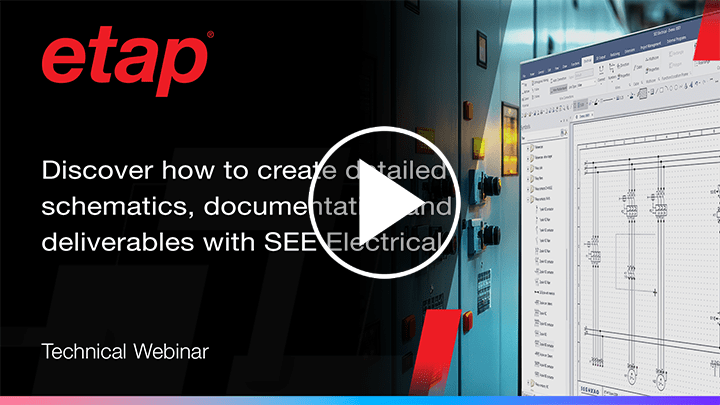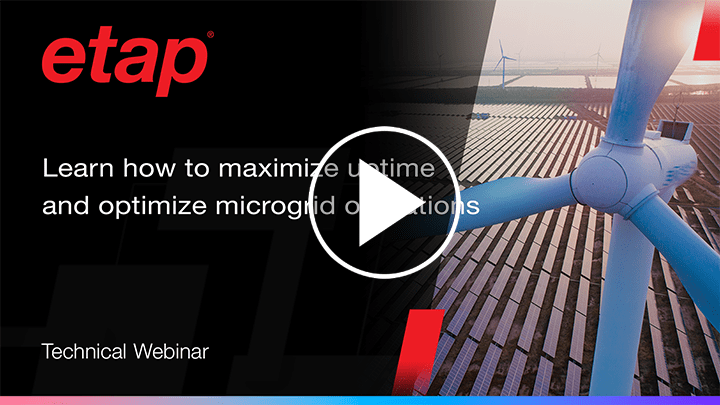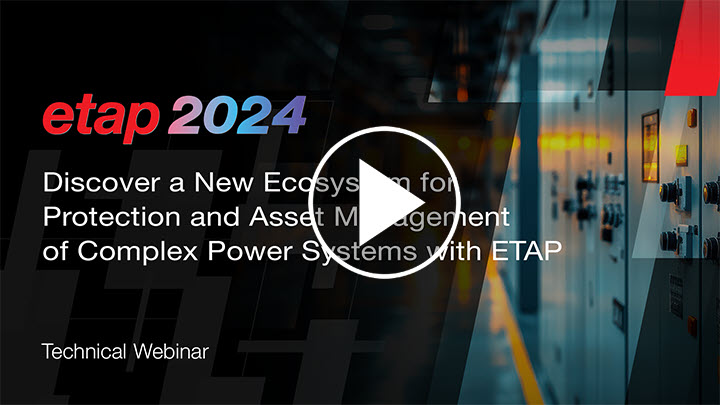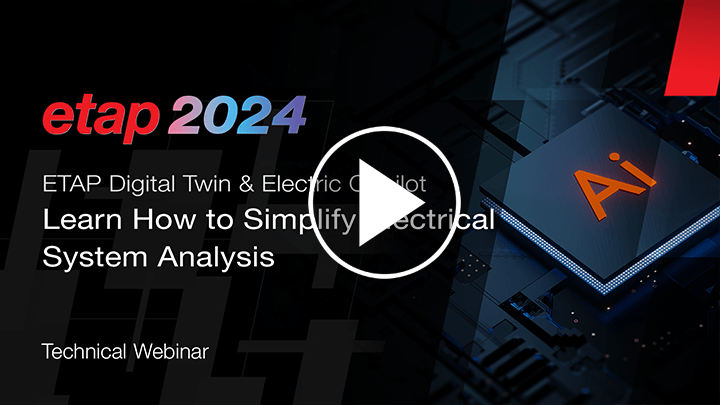272 Item(s) found

Using ETAP to Evaluate Ground Fault Trips in a Microgrid
- 21:17
- Case Study
Adding distributed generation sources to existing power distribution systems and the implementation of islanding microgrid capability introduce protection and control challenges if not properly designed. Each new generator may present a new source ground fault current to the system, which can result in unanticipated breaker operation. Energy Systems Group, was using ETAP to model the system and check coordination of local and remote breakers can reduce downtime and troubleshooting.

Generator Brush Collector Ring’s Arc Flash Hazard, A Safety Concern!
- 14:49
- Case Study
For some types of generator exciter systems, collector rings and brushes are used to provide energy from the exciter to the rotating field. The brushes wear down and constantly need to be replaced with the unit on-line and while brush/ring assembly is still energized, a risky and unsafe maintenance operation and may cause a serious harm. A potential shock and arc-flash hazard. This presentation addresses the important and dangerous maintenance of worn-down collector rings and brushes, electrical safety, lack of standards and guidelines, and a first possible calculation method.

AC and DC Arc Flash Methods for Renewable Energy Systems
- 25:46
- Case Study
This presentation will address the difficulties and lessons learnt on performing arc flash analysis using available methods (outside the voltage limits of IEEE 1584-2018 standard) on a 2.3 MW PV generation facility. The analysis includes system modeling, short-circuit, arc flash (both AC and DC) using various applicable calculation methods that best fit this application along with available tools in ETAP and generating worst-case arc flash deliverables.

AC Arc Flash Analysis for a Datacenter Network in Italy to determine the PPE for Workers using ETAP
- 17:04
- Case Study
Arc Flash Analysis was performed on a new datacenter building in Italy, calculating Incident Energy and Arc Flash Boundaries at several locations, from the main 15kV distribution switch gears down to the main LV distribution switchboard and diversionary panel boards in each segment. The studies were performed using ETAP Arc Flash software to identify the correct personal protection equipment (PPE) for engineering staff during maintenances operations. Standards applied include: NFPA 70E-2021, IEEE 1584-2018, IEC 60909 (2016).

GreeNext to Provide Sustainable and Resilient Energy-as-a-Service, in Collaboration with ETAP
- 19:50
- Case Study
This presentation introduces GreeNext, a joint venture providing sustainable and resilient energy solutions to commercial and industrial customers through solar and battery hybrid microgrid technology. Learn how and why GreeNext will utilize ETAP Software and controller hardware to increase deployment speed and provide an additional layer of reliability for Data Centers.
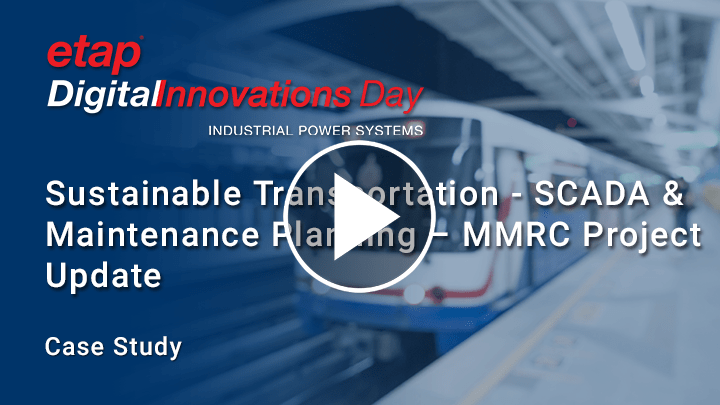
Sustainable Transportation - SCADA & Maintenance Planning – MMRC Project Update
- 20:00
- Case Study
Today’s Transportation businesses call for sustainable mobility. The goal is to deliver an end-to-end digital solution throughout the asset lifecycle to optimize critical mobility infrastructure management for the optimal customer experience in rail, airports, roads, and ports.
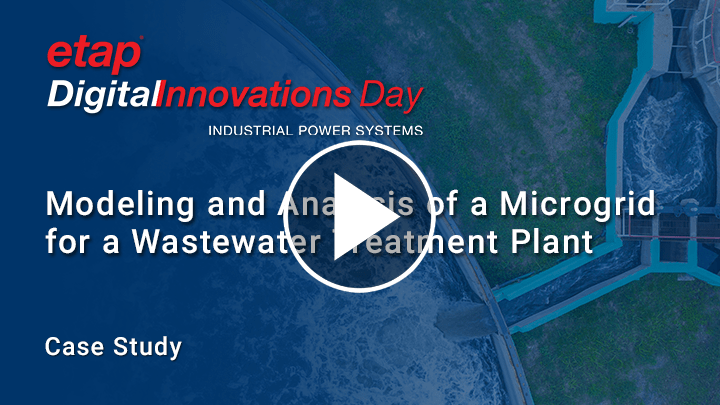
Modeling and Analysis of a Microgrid for a Wastewater Treatment Plant - AECOM
- 16:21
- Case Study
Engineering and operation objectives of mission-critical facilities require a reliable and secure power supply system. Microgrids have become the leading technological solution for a resilient and sustainable supply of electricity for critical infrastructures. This paper presents ETAP-based power system studies of a microgrid designed for a mission-critical facility, a wastewater treatment plant (WWTP). The microgrid consists of a behind-the-meter (BTM) solar photovoltaic (PV) system, a battery energy storage system (BESS), a combined heat and power (CHP) generator, and standby diesel generators. We modeled this microgrid by leveraging the ETAP software and performed power system studies for both grid-connected and islanded modes of operation. Several scenarios were created based on different loading conditions and power source combinations, which are utilized to validate the power system studies. We will discuss the model of the power system investigated, operational strategy and sequences of operation, findings, challenges, lessons learned, and future works.

Powering IT/OT Convergence for DC Management in Data Centers with ETAP
- 21:26
- Case Study
Electrical infrastructure can only be managed by including both equipment and data. Transforming electrical data to information and knowledge for decision-makers of mission-critical facilities requires IT-compatible software with the latest technologies’ integration capabilities. This presentation shows how ETAP enables end-users to achieve sustainable operations in their critical facilities by fulfilling OT/Site Management and IT Management requirements. ETAP’s unique features are configured with respect to data center topology and sustainable operation principles. These features are enriched as we have positioned ETAP in the corporate environment of end-users, where their corporate IT standards, services, and tools are integrated. As the title suggests, both OT and IT protocols are commissioned together, and the management of electrical infrastructure is powered by IT services via ETAP.

Upgrading Bokaro Steel Plant's existing Supervisory Load Control Centre System with ETAP SCADA
- 14:47
- Case Study
Steel Authority of India Limited (SAIL) is one of the largest steel-making companies in India and one of the Maharatnas of the country’s Central Public Sector Enterprises. ETAP was selected to upgrade the existing SLCC (Supervisory Load Control Centre) System for Power Distribution of Bokaro Steel Plant. This presentation will give insights into the project scope and deployment: The SCADA/PDMS system shall monitor and control the Distribution & Sub-Distribution stations and achieve the SCADA/PDMS functions, integrated with the SLCC control center. Bokaro Steel Plant (BSL) is having a client/server architecture-based SCADA System for monitoring and controlling of generation, import, and distribution of power through SLCC Control room at MSDS-I. The SLCC system is also connected to a central SLCC system located in Kolkata. RTUs for substations will be installed in various locations which are connected through a dedicated fiber-optic network to the server.
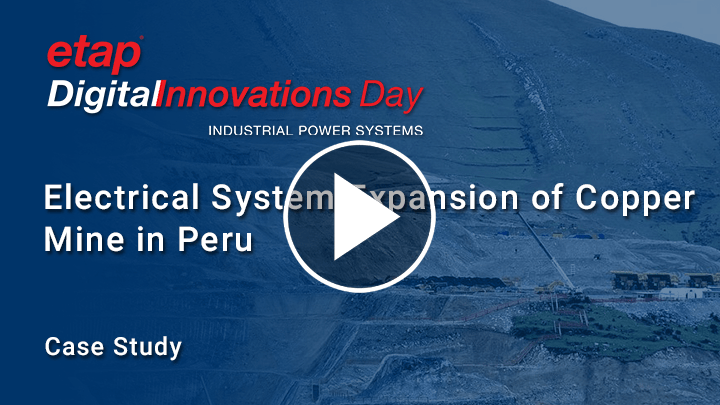
How ETAP was utilized to expand the Electrical System at the Tailings Dam Copper Mine in Peru
- 14:07
- Case Study
As part of their Tailings Dam Expansion project, a large copper mine in Peru required to have several studies performed in their electrical system. As loads were added and the topology of the system was changing, the client wanted to ensure that their electrical system would be able to handle the new loads and operate reliably and efficiently. Electro Integra S.A.C. was hired to perform Load Flow, Short Circuit, Relay Coordination, Motor Starting and Optimal Capacitor Placement studies. ETAP was used as the tool to perform all the studies because the client has been using ETAP for over 20 years.

Ground Grid Design with ETAP in a Steel Plant in Mexico - EPSOL
- 16:00
- Case Study
A Ground Grid design project is presented in a steel plant in Mexico and the objective is to reduce the step and touch potentials in the area of electric arc furnaces of 50 kA connected to transformers of 13.8/0.6 KV and that in the moment of melting, they create dangerous currents for the workers who operate these furnaces. The project is executed from the field measurements of the resistivity of the ground and the design of the ground grid with the ETAP finite element method (FEM) and the construction of the grid is executed up to the foot of the ovens, thereby reducing said potentials to safe values for the workers, contributing to a safer work area.
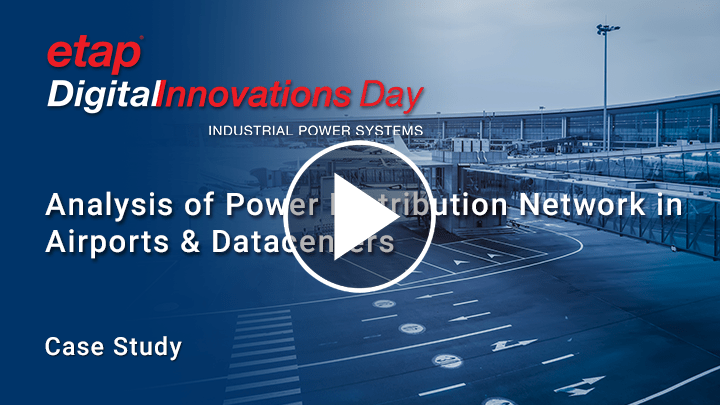
Analysis of power distribution network in Mission critical areas – Airports & Datacenters
- 11:00
- Case Study
ETAP Power System Software, with its various analysis modules is used to validate the design of Larsen & Toubro Construction – Buildings and Factories projects in airports, data centers, hospitals, office buildings etc. Network Analysis, such as Load Flow and Short Circuit Calculations, ensure load shedding and voltage drop within permissible limits, Transformer Sizing Analysis is utilized to meet standard requirements. Cable Sizing and Cable Pulling Modules, along with UG Thermal Analysis modules, validate cable routing at various underground locations. These tools allow for easy planning and approval at the initial project stage. On Safety and Protection – STAR curves help to find the correct protection and selectivity for prestigious projects with critical operations such as airports, data centers, office buildings and hospitals, to ensure smooth power flow without interruptions. Arc Flash Modules help us to quickly create & define Arc Flash Labels, as well as PPE requirements. Ground Grid Analysis is used for effective and economical earth mat design and sizing. Reliability Assessments are part of the design process to ensure the AIDI and CAIDI reliability metrics. Harmonic Analysis, for the sizing of active and passive filters allows for fine-tuning of filter design at the right locations.

Online Monitoring of Nuclear Power Plant Auxiliary Power Systems using ETAP Real-Time
- 23:54
- Case Study
At a given nuclear power plant, nuclear safety is directly dependent on a reliable source of electric power supplied via the plant’s auxiliary power system. The auxiliary power system typically consists of an MV and LV AC and a DC distribution system, powering thousands of individual loads and circuits, i.e., pumps, fans, valves, sensors, and controls specifically designed to protect the integrity of the nuclear reactor and containment structures. This presentation will explore past practices and recent developments in the online monitoring of such systems using a digital twin. The presentation includes the reasons for utilizing online monitoring, the advantages of using a digital twin versus simple data collection, and the multi-faceted benefits realized from such a system (i.e., business, safety, reliability).

Industrial Plant Electrical Risk Management Program
- 12:33
- Case Study
The Electrical Risk Management (ERM) group at FTI uses ETAP to provide short circuit, coordination, and arc flash studies as a part of building a safety program for industrial facilities around the US and Canada. This presentation will describe our approach to an overall safety program and the ways that a safety program encompasses more that just an engineering study. Some topics to be discussed are the need for maintenance personnel to understand the labeling, assessing the risk vs. just looking at the label, the choice between full coordination and arc flash hazard, field verification, and bolted fault current vs arcing fault current as it relates to equipment evaluation. We will look at the ETAP model of one of our industrial customers and discuss the benefits of using ETAP for our studies – reliability, adaptability to many systems by using configurations and scenarios, wizards, availability of DC and MV calculations, Star TCCs, ease of exporting reports to Excel, and solar and wind sources capability.

How to dynamically model & analyze generator stability during step loading using ETAP software
- 16:42
- Case Study
This study simulates the impact of step loading on the transient stability of a 2 x 25 MW GTG-based captive power plant at one of the Chemical Fertilizer Plants located at Trombay, India. The variation of electrical frequency and terminal voltage of the generator during the most conservative step loading of one generator unit is studied. The loads divided in steps are switched at certain time intervals to determine whether the frequency profile of the system is within the acceptable limit of ±5%. Load Flow and Short Circuit Studies are performed on the entire power plant distribution network of the fertilizer plant in advance to check the adequacy of equipment ratings during normal and short circuit conditions with all verified input data. The step load response study is carried out with only one GTG unit running in isolation, feeding only the critical emergency loads. Transient behavior of the GTG unit is simulated with IEEE transfer function dynamic models, viz. AC8B model of excitation system (AVR) and IEEE GGOV1 model for turbine governing system using the in-built standard library in ETAP software version 16.1.0. Various parameters of the generator like speed, active and reactive power, bus voltage, and frequency are plotted for determining the transient performance of the GTG unit.

ETAP ArcSafety Solution Overview - A comprehensive suite of Arc Flash software analysis tools
Learn about ETAP ArcSafety, an all-in-one AC & DC arc flash solution for LV, MV & HV systems that improves safety, reduces risk, minimizes equipment damage, and validates mitigation techniques.

- 54:39
- Webinar
This webinar outlines how ETAP Microgrid Control Solution devises and implements adaptive strategies to enable a smooth transition between grid-connected and islanded modes during unplanned islanding.
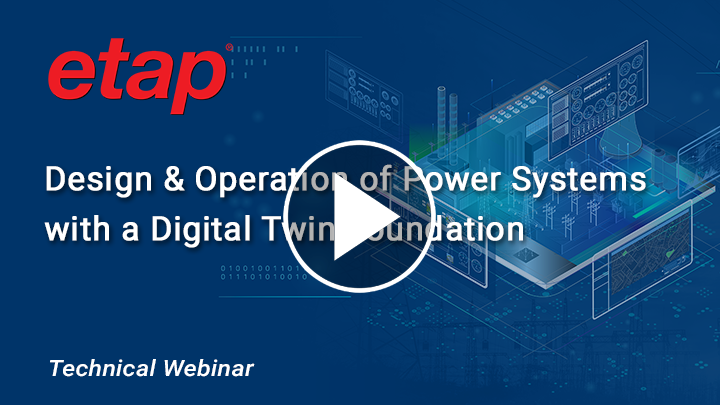
Design & Operation of Power Systems with a Digital Twin Foundation
- 37:30
- Webinar
This webinar introduces an integrated model-driven approach for engineers and managers to design and operate power systems. ETAP’s Digital Twin Platform combines electrical, mechanical, and thermal properties with intelligent visualization for modeling, design, automation, and real-time predictive analysis. Learn how ETAP’s unique multi-dimensional database eliminates the need for hundreds of copies of the project file, by providing unlimited graphical presentations, configurations, data revisions, loadings, generations and operational values within the same project database. Moreover, ETAP unified platform allows simultaneous analysis of the network under various conditions.

Utilize ETAP GIS To Better Design, Analyze & Expand T&D Networks - ETAP Project Management Webinar Series Part 4
- 30:53
- Webinar
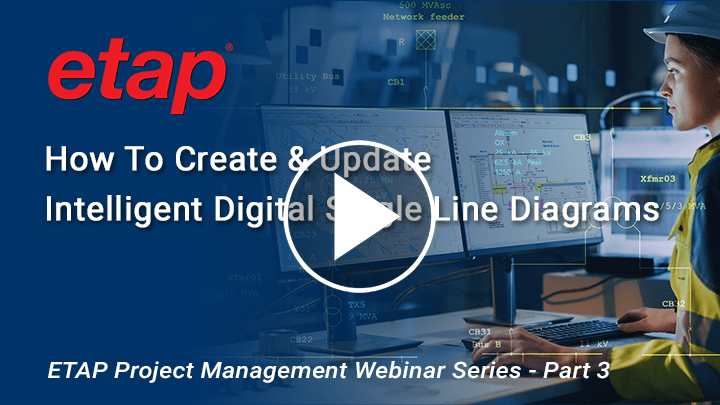
ETAP iSLD - Intelligent Electrical Single-Line Diagram - ETAP Project Management Webinar Series Part 3
- 36:49
- Webinar
ETAP's intelligent electrical single line diagram (iSLD) is a multi-layered one-line view of the digital-twin, that includes advanced functionality and awareness of the device's characteristics and system behavior. It is an active blueprint and the foundation of your digital transformation journey.


